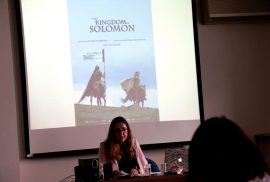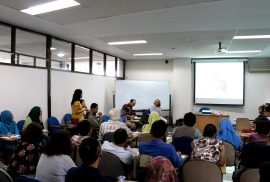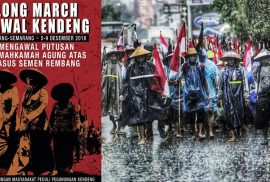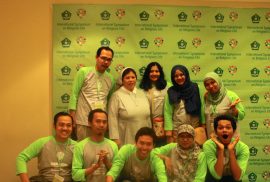Meta Ose Ginting | CRCS | WedForum Report

Going to the cinema is a new social practice in modern society. To some extent it can also be perceived as a spiritual practice. Dr Nacim Pak-Shiraz, the Head of Persian Studies and a Senior Lecturer in Persian and Film Studies at the University of Edinburgh and guest speaker at the Wednesday Forum on February 9th, studies this paradox in the dynamics of Iranian cinema. She began by noting that there has been only a little academic attention to the movies based on Quranic epics, in contrast to what has happened with Biblical epics from Hollywood.
Meta Ose Ginting | CRCS | WedForum Report

Jonathan Zilberg, a cultural anthropologist whose research and advocacy focuses on museum ethnography, argued that Indonesian museums face such problems as performance, transparency and accountability, but they have the potential power to promote pluralism to the public. In his February 1st Wednesday forum presentation, he raised questions as to how Indonesian museums can be a strong bond to serve Indonesia’s diversity.
Based on his research in National Museum of Indonesia in Central Jakarta, Zilberg argued that museums are an extension of culture and identity. He conducted his research by closely examining the activities of visitors of National Museum. He took photos from different angles and then reflected on how visitors interact with the objects on display. He stressed that a museum that functions well should be a place to learn and display democracy. Different people come to the museum with various interests. These differences can lead them to learn about pluralism in comfortable ways.
Samsul Maarif | CRCS | Perspektif

Ibu Bumi wis maringi (Ibu Bumi sudah memberi)
Ibu Bumi dilarani (Ibu Bumi disakiti)
Ibu Bumi kang ngadili (Ibu Bumi yang mengadili)
La ilaha illallah, Muhammadun rasulullah (3x)
Pada 20 Mei 2016, “Doa Nusantara” ini dilantunkan oleh ribuan warga Pati sebelum dan saat melakukan aksi jalan kaki (long march) sepanjang 20 kilometer dari Petilasan Nyai Ageng Ngerang di Kecamatan Tambakromo menuju alun-alun Kota Pati untuk mengajak semua pihak melestarikan pegunungan Kendeng. Lantunan doa itu kembali menggema pada aksi long march berikutnya yang menempuh 150 kilometer dari Rembang ke Semarang pada 5-8 Desember 2016.
Mereka datang menuntut Gubernur Jawa Tengah Ganjar Pranowo untuk mematuhi putusan Mahkamah Agung yang pada 5 Oktober 2016 telah mengabulkan Peninjuan Kembali (PK) gugatan mereka atas izin lingkungan kepada PT Semen Gresik (kemudian menjadi PT Semen Indonesia). Doa itu terlantun kembali oleh Gunretno, koordinator Jaringan Masyarakat Peduli Pegunungan Kendeng (JMPPK), pada acara MetroTV, “Mata Najwa: Bergerak Demi Hak”, 21 Desember 2016. Sebelumnya, pada 11-13 April 2016, sembilan “Kartini Kendeng” menyemen kakinya di depan Istana Negara.
Rangkaian unjuk rasa yang tidak biasa itu adalah bukti bahwa para petani sungguh merasa terancam oleh pembangunan pabrik semen di wilayah tempat mereka tinggal di sekitar pergunungan Kendeng—dan mereka sudah menolak pembangunan pabrik semen sejak 2006. Kesungguhan itu lahir dari tradisi yang mengakar di masyarakat lokal, yang di dunia akademik biasa disebut “ekologi adat”.
Praktik Ekologi Adat Kendeng
Ekologi adat adalah rangkaian praktik dan pengetahuan adat yang menekankan kesatuan dan kesaling-tergantungan manusia dan lingkungan, yang mencakup berbagai wujud seperti tanah, hutan, batu, air, gunung, binatang, dan lain-lain. Dalam ekologi adat, eksistensi dan jati diri manusia bergantung dan hanya dapat dipahami dalam konteks relasinya dengan lingkungannya. Keberlanjutan hidup manusia identik dengan kelestarian lingkungan, dan kerusakan lingkungan adalah kehancuran manusia.
Ekologi adat adalah penyesuaian dengan istilah-istilah yang sudah berkembang dalam literatur akademis, seperti indigenous ecology, local ecology, traditional ecology, dan seterusnya. Salah satu inti dari bangunan pengetahuan tersebut adalah bahwa ekologi bukan hanya rangkaian pengetahuan (body of knowledge), melainkan juga cara hidup (way of life) (McGregor 2004). Wajar saja jika Komisi Dunia untuk Lingkungan dan Pembangunan (World Commission on Environment and Development/WCED) sejak 30 tahun lalu menegaskan pentingnya masyarakat modern belajar dari pengetahuan dan pengalaman masyarakat lokal/adat terkait pengelolaan lingkungan (WCED 1987).
Fatwa MUI pada Desember 2016 tentang hukum menggunakan atribut non-muslim memerlukan sofistikasi argumen, rasionalisasi alasan, dan, di atas segalnya, kesadaran akan semangat zaman yang berubah.
M Rizal Abdi | CRCS | News
 Nowadays, religion frequently becomes a major source of violence, exclusion and misunderstanding. Almost every week, conflicts among religious people or institutions appear in the headlines. However, religion can also be catalyst for peace and harmony, reconciliation and social justice. At the same time, the state’s fundamental position in matters of religious policies also plays a significant role in managing the diversity. With these concerns in mind, the Centre for Research and Development of Religious Life (CRDRL) of The Ministry of Religious Affairs of the Republic of Indonesia (MORA) held “International Symposium of Religious Life (ISRL) 2016: Managing Diversity, Fostering Harmony” at Sari Pan Pacific Hotel, Jakarta on 5-7 October 2016. Bringing together researchers, activists, policy makers, and scholars of religious studies, the symposium was expected to offer opportunities for new ideas in developing religious studies as well as a variety of new formats for achieving harmonious religious life in plural society. “As the Ministry of Religious Affairs, we hope that this symposium might give us recommendations for implementing the vision of Indonesia diversity,” said Prof. Dr. Phil. Amin Kamaruddin, General Director of Islamic Education, representing the Minister of Religious Affairs.
Nowadays, religion frequently becomes a major source of violence, exclusion and misunderstanding. Almost every week, conflicts among religious people or institutions appear in the headlines. However, religion can also be catalyst for peace and harmony, reconciliation and social justice. At the same time, the state’s fundamental position in matters of religious policies also plays a significant role in managing the diversity. With these concerns in mind, the Centre for Research and Development of Religious Life (CRDRL) of The Ministry of Religious Affairs of the Republic of Indonesia (MORA) held “International Symposium of Religious Life (ISRL) 2016: Managing Diversity, Fostering Harmony” at Sari Pan Pacific Hotel, Jakarta on 5-7 October 2016. Bringing together researchers, activists, policy makers, and scholars of religious studies, the symposium was expected to offer opportunities for new ideas in developing religious studies as well as a variety of new formats for achieving harmonious religious life in plural society. “As the Ministry of Religious Affairs, we hope that this symposium might give us recommendations for implementing the vision of Indonesia diversity,” said Prof. Dr. Phil. Amin Kamaruddin, General Director of Islamic Education, representing the Minister of Religious Affairs.
Following keynote addresses by Prof. Azyumardi Azra (UIN Syarif Hidayatullah, Jakarta), Prof. Robert W. Hefner (Boston University), and Prof. Gamal Farouq Jibril (Al-Azhar University, Cairo) who presented their fruitful insights in the plenary session, more than 100 participants from various backgrounds and countries attended the forum. The participants were rigorously selected based on their abstracts from hundreds of submissions from Indonesia and around the region. Three current CRCS students were invited to become participants in this forum. Azis Anwar Fachruddin from the 2014 batch delivered a paper entitled “Indonesia’s Indigenous Belief and Modern Construction of Religion” which challenged the paradigm of “world religions” in constructing the religion definition in Indonesia. The paper by Ali Ja’far from the 2015 batch was entitled “Promoting Religious Tolerance through Religious Tourism: Managing Religious and Ethno-Political Conflict in Tuban.” It gives alternative perspective of tourism as “dialog of hand” (practical measures) in reconciliation of ethno-religious and political conflicts. M Rizal Abdi from the 2015 batch discussed the issue on negotiation of space and place in pilgrimage studies when he presented his ongoing research entitled, “Tembayat Pilgrimage as Space of Harmony: Exchanging Symbols, Negotiating Spaces.”
 In addition to the three current students, seven CRCS alumni also took part in the symposium: Achmad Zainal Arifin (2000), lecturer in Sociology program in UIN Sunan Kalijaga; Erik Sabti Rahmawati (2001), lecturer in Syariah Faculty UIN Maulana Malik Ibrahim; Ubed Abdillah (2001), lecturer of General Education in Buddhi Dharma University Tangerang; Elis Z. Anis (2001), Financial Development Executive at the Indonesian Consortium for Religious Studies (ICRS); Al Khanif (2004), lecturer and director of Research Institute of Human Right, Faculty of Law, Jember University Indonesia; A. Syamsu Madyan (2004), lecturer of Islamic Studies at the Graduate School of Unisma Malang; and Achmad Fawaid (2012), a lecturer of IAI Nurul Jadid Paiton Probolinggo.
In addition to the three current students, seven CRCS alumni also took part in the symposium: Achmad Zainal Arifin (2000), lecturer in Sociology program in UIN Sunan Kalijaga; Erik Sabti Rahmawati (2001), lecturer in Syariah Faculty UIN Maulana Malik Ibrahim; Ubed Abdillah (2001), lecturer of General Education in Buddhi Dharma University Tangerang; Elis Z. Anis (2001), Financial Development Executive at the Indonesian Consortium for Religious Studies (ICRS); Al Khanif (2004), lecturer and director of Research Institute of Human Right, Faculty of Law, Jember University Indonesia; A. Syamsu Madyan (2004), lecturer of Islamic Studies at the Graduate School of Unisma Malang; and Achmad Fawaid (2012), a lecturer of IAI Nurul Jadid Paiton Probolinggo.
“The issues that were elaborated on in plenary and panel sessions looks like extended versions of our daily discussions in the classroom at CRCS,” said Jafar. At the same time, the symposium also helped student in finding cutting-edge discourse on religious studies research. “The discussants were quite critical but the discussions enriched the research questions as well as refined my analysis,” Abdi remarked after his presentation. The participation of ten CRCS students and alumni in this international symposium not only shows CRCS’s remarkable academic track records in religious studies but also demonstrates the continuous efforts of CRCS’s big family in building bridges in the world of diversity.
Negotiating Women’s Modesty in the Gendered Dynamics of Minang Society
M Rizal Abdi | CRCS | Wednesday Forum Report
The woman knelt down, supporting her body wrapped in traditional Minang cloth. She held a microphone that echoed her reedy singing and reverberated with the sound of flute from the man next to her. Suddenly, the sound of electronic music rushed in, disrupting the serene and heartbreaking melody with the upbeat dangdut rhythm. Still kneeling down and the female singer continued her sad singing with contradictory backsound as if it is synchronized to each other.
“Two decades ago, this wouldn’t be happening,” said Jennifer A. Fraser, Associate Professor of Ethnomusicology and Anthropology from Oberlin College, US. The contradictory yet fascinating scene above was shown during Fraser’s presentation in CRCS-ICRS Wednesday Forum on Wednesday, 8th August 2016. Entitling her presentation “Playing with Men: Female Singers, Porno Lyrics, and the Male Gaze in a Sumatran Vocal Genre”, Fraser shared her latest findings on Saluang Jo Dendang (literally flute with song), one of the Minangkabau music arts which is celebrated for its refined poetry based on allusions and its sad songs that induce tears in a listener. Using ethnographic research in West Sumatra dating from 1998, she tracked the gendered dynamics and increasingly sexualized interactions between female singers and their male audiences. In the 1960s, Saluang Jo Dendang was predominantly a male performance. Based on Minangkabau Islamic modesty, it was not considered appropriate for women to attend such an exclusively male event, let alone become the center of attention. The only possibility for a woman to participate as a performer was when her husband was the flute player. However, by the 1990’s, women started to displace men as the singer or pededang so that nowadays male pedendang are extremely rare. In fact, as one of male singers admitted, no one wants to listen to a male pedendang anymore.
Moreover, Fraser showed that there are shifting relations between the padendang and pagurau or attendees. In the past, with male singers, the pagurau usually listened to the song and fell into deep reflection on the lyrics. Sometimes the pagurau could also make song requests to the padendang directly. Nowadays, the pagurau usually tease or seduce the padendang by throwing some off-color jokes or requesting particular themes like divorce, asking for marriage, or other private matters. However, according to Fraser, the porno lyrics in the saluang performance refer to something different from the common understanding of pornography. Rather than explicitly using sexual vocabulary, most of lyrics categorized as porno by the audiences refer to anatomical description through allusion that tends to be not harmful but playful. For example,






